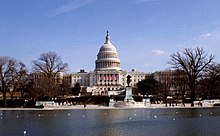
Back كونجرس امريكا ال103 ARZ 103. Kongress der Vereinigten Staaten German 103ο Κογκρέσο των Ηνωμένων Πολιτειών Greek Kongres Amerika Serikat ke-103 ID 103º Congresso degli Stati Uniti d'America Italian
| 103rd United States Congress | |
|---|---|
102nd ← → 104th | |
 United States Capitol (1993) | |
January 3, 1993 – January 3, 1995 | |
| Members | 100 senators 435 representatives 5 non-voting delegates |
| Senate majority | Democratic |
| Senate President | Dan Quayle (R)[a] (until January 20, 1993) Al Gore (D) (from January 20, 1993) |
| House majority | Democratic |
| House Speaker | Tom Foley (D) |
| Sessions | |
| 1st: January 5, 1993 – November 26, 1993 2nd: January 25, 1994 – December 1, 1994 | |
The 103rd United States Congress was a meeting of the legislative branch of the United States federal government, composed of the United States Senate and the United States House of Representatives. It met in Washington, D.C. from January 3, 1993, to January 3, 1995, during the final weeks of George H. W. Bush's presidency and in the first two years of Bill Clinton's presidency. The apportionment of seats in the House of Representatives was based on the 1990 United States census.
This is the most recent Congress to have a Democratic senator from Texas, Bob Krueger, who lost election to finish Lloyd Bentsen's term in 1993. Along with two Democratic senators from the state of Tennessee, Jim Sasser and Harlan Mathews. Jim Sasser lost re-election and Harlan Mathews retired in 1994. In addition, a Democratic senator from the state of Oklahoma, David Boren, resigned in the final weeks of the Congress.
Both chambers maintained a Democratic majority, and with Bill Clinton being sworn in as president on January 20, 1993, this gave the Democrats an overall federal government trifecta for the first time since the 96th Congress in 1979.
Cite error: There are <ref group=lower-alpha> tags or {{efn}} templates on this page, but the references will not show without a {{reflist|group=lower-alpha}} template or {{notelist}} template (see the help page).